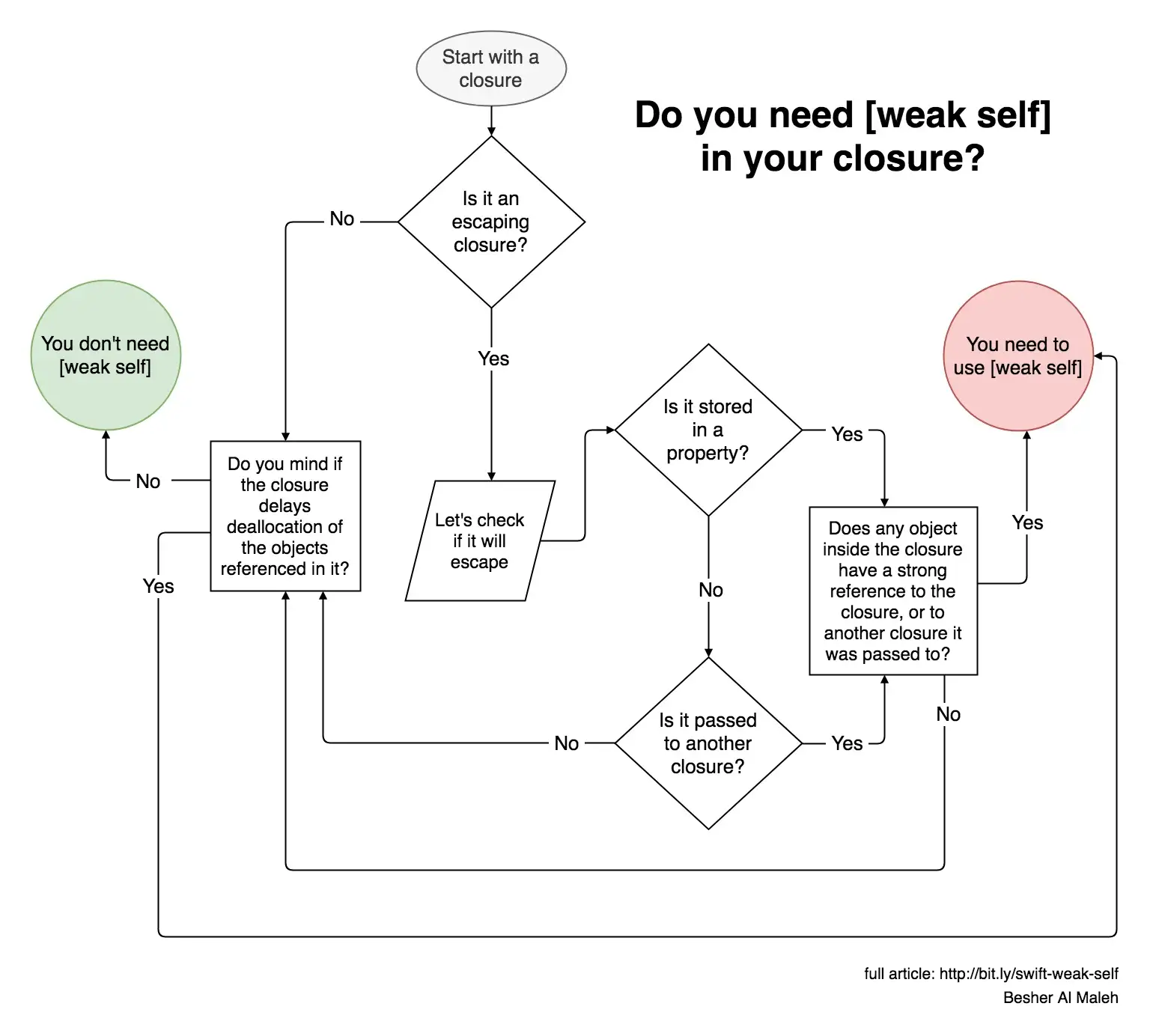I assume you have basic concepts about Retain Cycles and know how to avoid them by adding [weak self] inside closures. However, you may still encounter situations where you cannot release objects as expected even if you have followed best practices.
The code below demonstrates a recursive call scenario. You can download the project here. When entering the DetailViewController, we execute the pay function and call the class function payMoney, which is a simplified function simulating API call. Inside the payMoney function, it simply returns an empty closure. In the payMoney’s callback, we monitor the retryCount and after one second we call the pay function recursively if the retryCount is greater than zero. Have you spotted any problems?
1
2
3
4
5
6
7
8
9
10
11
12
13
14
15
16
17
18
19
20
21
22
23
24
25
26
27
28
29
30
31
32
33
34
35
class PayAPI {
class func payMoney(completion: @escaping () -> ()) {
completion()
}
}
class DetailViewController: UIViewController {
override func viewDidLoad() {
super.viewDidLoad()
pay()
}
var retryCount = 10
func pay() {
PayAPI.payMoney { [weak self] in
guard let self = self else { return }
if self.retryCount > 0 {
DispatchQueue.main.asyncAfter(deadline: .now() + 1) {
print("count down \(self.retryCount)")
self.retryCount -= 1
self.pay()
}
} else {
print("I paid the bill")
}
}
}
deinit {
print("I left.")
}
}
Everything looks just fine. We use [weak self] inside the payMoney’s callback to prevent memory leaks. We use guard to unwrap self as many people will do to get rid of the annoying optional mark(“?”). Then, we call the pay function inside the asyncAfter’s closure. Nothing suspicious, right?
However, if you leave the DetailViewController during the recursive calls, you will see that the recursion continues even though you have left the DetailViewController. Hmmm…seems like a memory leak. But how does it happen?
Well, it’s actually not a leak. According to Apple’s document, a memory leak occurs
when allocated memory becomes unreachable and the app can’t deallocate it.
The memory is not unreachable in this case. When the recursion hits the bottom case, the DetailViewController will be released, as seen by the deinit message being printed. This is not a memory leak, but rather a “delayed deallocation” issue, meaning the object is not being released at the expected time.
If we look at the code again, we can see that asyncAfter is a nested closure which keeps a reference to the strong self unwrapped by guard. This is why the DetailViewController remains alive in the background even after you have navigated away from it. To fix this, you can add [weak self] inside the asyncAfter closure, which will cause the DetailViewController to be released immediately when you leave the page. Alternatively, you can remove the guard let self = self line and make all selfs optional.
While browsing the Internet, I found Besher Al Maleh’s article to be extremely helpful. I highly recommend reading it. The article also includes an epic flowchart for determining when to use weak self inside a closure.

Maleh’s demo sample also provides an example of delayed deallocation caused by a sempaphore:
1
2
3
4
5
6
7
func delayedAllocSemaphore() {
DispatchQueue.global(qos: .userInitiated).async {
let semaphore = DispatchSemaphore(value: 0)
print(self.view.description)
_ = semaphore.wait(timeout: .now() + 99.0)
}
}
Besides, if you set a long time interval in the URLSessionConfiguration, it will also lead to delayed deallocation.
1
2
3
4
5
6
7
8
9
10
11
12
13
14
15
16
17
18
19
/* If you execute the URLSession task immediately, but set a long timeout interval, it will delay the deallocation of your controller until you either cancel the task, get a response back, or timeout. Using [weak self] will prevent that delay. Note: Using port 81 on the url helps simulate a request timeout */
func delayedAllocAsyncCall() {
let url = URL(string: "https://www.google.com:81")!
let sessionConfig = URLSessionConfiguration.default
sessionConfig.timeoutIntervalForRequest = 999.0
sessionConfig.timeoutIntervalForResource = 999.0
let session = URLSession(configuration: sessionConfig)
let task = session.downloadTask(with: url) { localURL, _, error in
guard let localURL = localURL else { return }
let contents = (try? String(contentsOf: localURL)) ?? "No contents"
print(contents)
print(self.view.description)
}
task.resume()
}

Comments powered by Disqus.